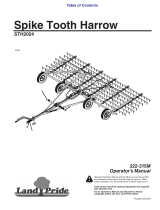
Copyright 2020 DoorKing
®
, Inc. All rights reserved.
1610-062-D-5-20
120 S. Glasgow Avenue
Inglewood, California 90301
U.S.A.
3-Ft Spike Rod Access Slots
Traffic Direction
3-Ft Spike Rod Access Slots
Lower Spikes
Traffic Direction
Only when spikes are raised
Raise Spikes
78”
4.75”
3”
4.75”
3”
8.5”
Firmly Packed Soil
Typically 10” Min
14.5” using
standard
8” x 8” x 16”
concrete
block.
Gravel
Load gravel inside the trench up to the top
and inside the holes in the concrete blocks.
This will help the drainage process and
avoid soil run-off underneath roadway.
How Lock-Down Tools Function
The spike springs are attached to two
separate 3-ft spike rods inside the
housing. Spikes are lowered or raised
10 at a time using BOTH lock-down
tools at the same time. This process
must be preformed TWO times to
lower or raise ALL 20 spikes.
DO NOT let any concrete or debris get inside the spike housing!
This will interfere with the internal moving parts and prevent the spikes from operating properly.
Poured Concrete
Pour concrete completely around
the Spike system. Make sure ALL
surfaces are flush with each other.
Tape
(Not supplied)
Use tape to protect
spike slots and bolt heads
when pouring concrete.
2 Lock-Down Tools
Required to lower or raise spikes.
Four (4) Standard
8” x 8” x 16”
Concrete Blocks
Position the spike system on
LEVEL concrete blocks. This will
elevate the spike system above
the base of the trench and allow
for proper drainage and help
avoid corrosion.
MUST be Level and Flush with Roadway!
3-ft Spike Rod
Spike Rod
Access Slot
Lock-Down Tool
2 lock-down tools in
position to lower 10 spikes
8”
6.5”
Roadway
SPRING-LOADED FLUSH MOUNT STAND-ALONE TRAFFIC SPIKE SYSTEM
Firmly Packed Soil
RoadwayRoadway
Concrete Block Cutaway
Cutaway End View
Lock-Down Tool
Attached to Spike Rod
Only attach lock-down tool
as shown to prevent extended
springs from snapping back.
Installation
Roadway
Concrete
Spikes in Lowered Position
72” Housing Length
10 Spikes in Lowered Position
10 Spikes in Raised Position
Insert BOTH
lock-down tools in
access slots indicated above
and firmly pull tools up and over.
Springs will extend...
...then
push tools
down...
...continue pushing down
until spike rod bottoms
out in LOWER
guide position.
Step 1 Step 2 Step 3
Insert BOTH lock-down tools
in access slots indicated above
and firmly pull tools up as
far as possible.
Springs will extend...
...then push
tools over until
spike rod reaches
top of guide.
Hold tools tight,
springs will want
to snap into raised
guide position!
Hold tools tight,
springs will want
to snap back!
Carefully lower tools until
spike rod bottoms out
in RAISED
guide position.
Step 3Step 2Step 1
Guide
Guide
Guide
Guide
Maximum Vehicle Weight: 8,000 lbs
Housing
Gravel in
concrete
block holes.
18” Min.
Concrete any narrower
than 18” inches wide
may have cracking
occur over time.
Lower or Raise Spikes
STOP
SEVERE TIRE
DAMAGE
WRONG WAY
NO PEDESTRIANS
IN TRAFFIC LANE
Identify Spikes to Vehicular Traffic
It is extremely important that traffic spikes are installed in an area
that is illuminated and clearly marked with warning signs
(DoorKing’s model 1615 illuminated warning sign kits).
Additional lighting, warning signs and pavement markings can be
used to increase awareness for potential danger and to separate
pedestrians from vehicular traffic.
Control Vehicular Traffic
Traffic must be slowed to a cautious speed prior to crossing the
traffic spikes to avoid accidents and excessive wear and tear on
hardware. Speed-bumps should be installed where additional
speed control is desired and also serves to prolong the life of the
traffic spikes (see 1610 speed bump for concrete surfaces).
Traffic spikes must always be installed at a 90° angle, never
installed in blind spots, corners, curves, (enough straight-away
must be available to allow vehicles that have just completed a turn
to straighten out and approach the spike system perpendicular to
the spikes).
Traffic spikes must be installed in flat-leveled concrete avoiding
bumps or dips including uphill or downhill slopes minimizing the
possibility of water draining into the spike assembly.
Regular Maintenance of Spike System
Regular inspection and removal of dirt, debris, gravel, and rock is
required in order to keep traffic spikes functioning properly.
Neglecting to regularly clean dirt and debris from inside traffic
spikes is the number one cause of excessive spring breakage
and traffic spike malfunction.
Traffic spikes are not intended for use on high stress facilities such
as hospitals, emergency rooms or busy roadways where vehicular
traffic is traveling at full speed.
Traffic spikes should only be
used in a parking situation or other areas where traffic
can be slowed to a maximum of 5 miles before crossing
the traffic spikes.
Failure to follow these guidelines may result
in bodily injury, vehicle damage and extreme wear and tear on
hardware.
Safety Information
YES NO
Spikes installed too
close to curve will
puncture vehicle tires.
5 MPH
DO NOT
BACK UP
Severe Tire Damage!
No Pedestrians in Traffic Lane
1615 Illuminated
Warning Sign
(P/N 1615-080)
Back of 1615 Warning Sign
1610 Speed Bump
(P/N 1610-150)
PLEASE READ THIS FIRST
2 tools
included with:
P/N 1610-082
2 tools
NOT included with:
P/N 1610-080
2 tools sold
separately:
P/N 1610-012
Lock-down position.
Lock-down position.
Trench
Dig a trench using to the overall spike
system and concrete block height and width.
Spike system MUST be flush with the roadway.
3-ft Spike Rod
“C” Clip
“Coil” Clip
End Spring
Connected to end of rod.
Springs Configuration
Middle Springs
Connected together.
Note: Dept of firmly
packed soil is dependent
on local soil conditions.
Check local building
code restrictions before
installation.
CAUTION: Installation and use of traffic control spike unit in areas that are subject to freezing weather with
the potential of snow and ice accumulation is not recommended. The unit may freeze in the up position and
cause unintended injury or damage due the inability of the spikes to retract.








